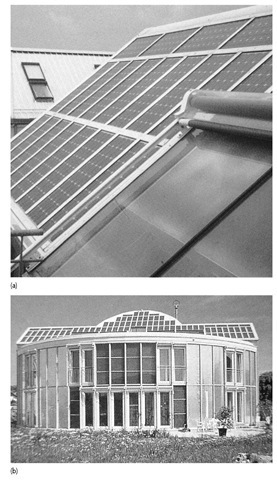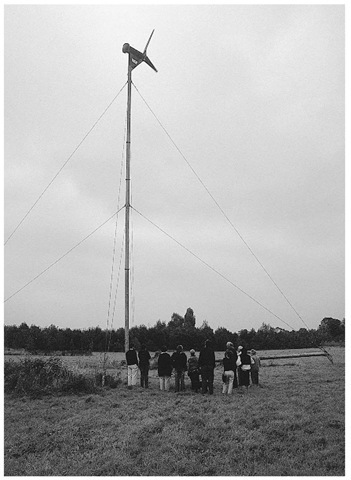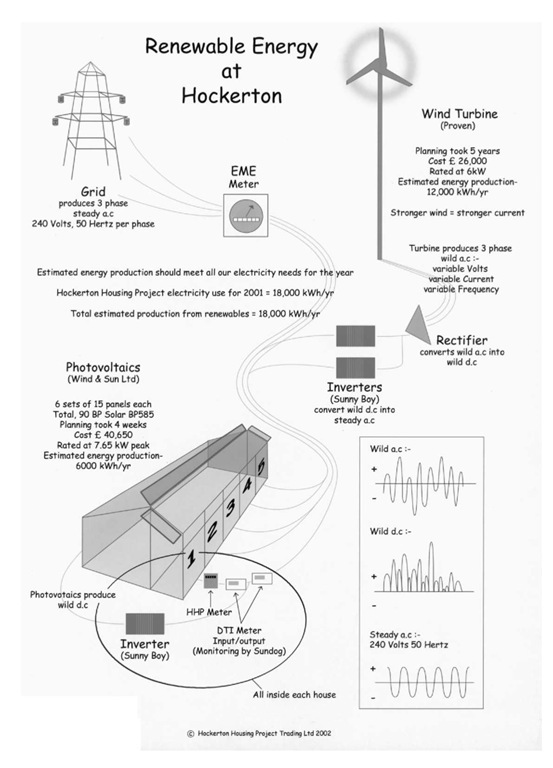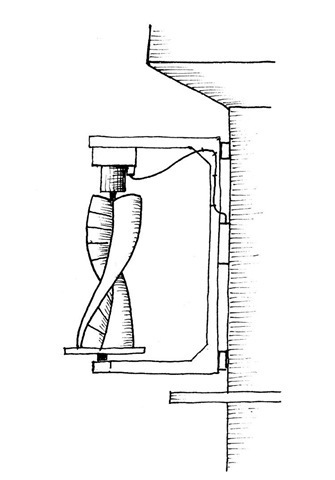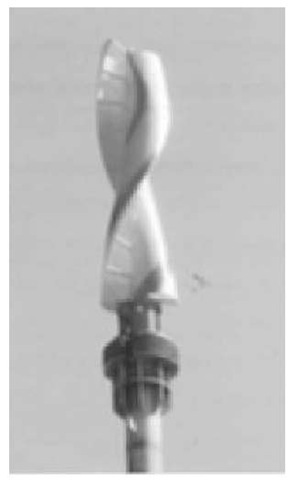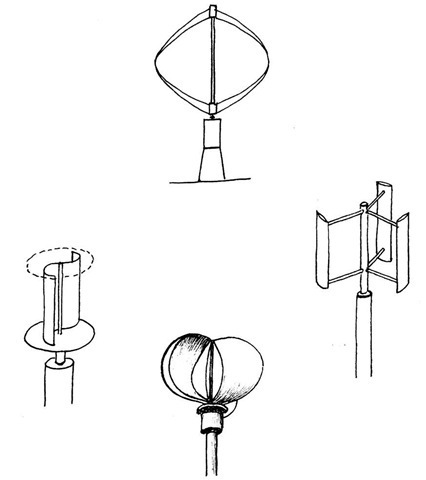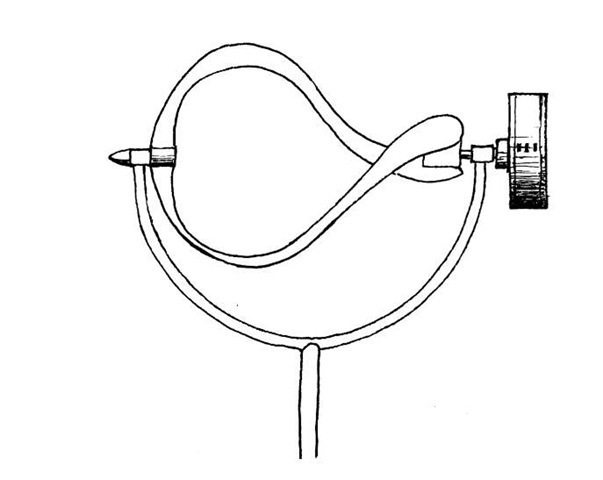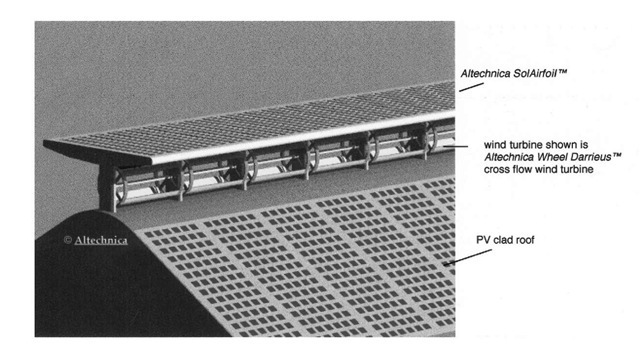Prospects for PVs in the developed countries
The European Photovoltaic Industry Association (EPIA) has made predictions about the penetration of PVs into the energy market by 2020. Worldwide PVs should be generating about 274 Terra Watt hours (TWh), which would be enough to meet 30 per cent of the electricity needs of the whole of Africa. Installed capacity would be 195 GWp of which half would be grid-connected in the industrialized countries. It is reckoned that about 80 per cent of the capacity in developed countries will be situated on residential buildings. That works out at 35 million people in Europe alone on the assumption that the average PV output for an individual home is 3 kWp serving three people. This amounts to nothing less than a revolution in the way electricity will be generated, offering considerable cash savings to householders and massive reductions in CO2 emissions. At today’s prices a PV module should, by then, cost about 1 Euro (US $1 or UK 70p) per Wattp. By 2040 the solar contribution is likely to reach 21 per cent of the world’s electricity output.
If these predictions are anywhere near the mark, it means that the unit cost of PV modules will fall substantially due both to technological improvements and economies of scale. Cells coated with light-sensitive dyes are close to market-ready and are expected to be one quarter the price of the current technology. In addition, solar cells have been produced in the laboratory which deliver a peak efficiency of 31 per cent, so we can expect significant improvements in the technology in the near future.
Figure 10.6 Solar house, Freiburg showing PVs and solar flat bed thermal collector with header tank.
Wind power
The home may not seem an obvious location for a wind generator. The public perception is of large ‘windmill’ rotors set in the landscape or off-shore. However, there is increasing interest in the development of small-scale or micro-wind generators suitable for attachment to buildings.
In this context ‘small’ means wind machines that are scaled from a few Watts to 20 kW. Machines between 1 and 5 kW may be used to provide either direct current or alternating current. They are mainly confined to the domestic level and are often used to charge batteries. The larger machines are more appropriate for groups of houses. As an example, the Hockerton Zero Energy Housing Project in Nottinghamshire has recently installed a 5 kW horizontal axis turbine rated at 270 V three phase, serving five homes. It is expected to generate 11 652 kWh per year. The height is 26 m and blade diameter 5.6 m. It exports excess load to the grid which will ultimately become profitable. The cost of the equipment was £19 300. The total cost including installation came to £26 142, including VAT at 5 per cent.
The supplier was Proven Engineering Ltd (www. proven-energy.com).
This scale of horizontal axis turbine is feasible where a group of homes can be recruited to join together to share the costs and benefits of wind power. It is also appropriate for homes in rural situations (Figures 10.7 and 10.8).
As stated earlier, small-scale electricity production on site has economic disadvantages in the UK given the present impediments to small-scale intermittent generation. Currently, the government is considering how to redress this inequity and thereby give a substantial boost to the market for small-scale renewables. Wind generation will do well if this happens, since it is at present usually less expensive in terms of installed cost per kilowatt than PV which makes it an attractive proposition as a building integrated power source.
Wind patterns in the built environment are complex as the air passes over, around and between buildings. Accordingly a wind generator introduced into this environment must be able to cope with high turbulence caused by buildings. Such conditions tend to favour vertical axis machines as opposed to the horizontal versions which have proliferated in wind farms. This is because the vertical versions may be able to operate at lower wind speeds and they are less stressed mechanically by turbulence.
Figure 10.7 Wind turbine, Hockerton Housing Project.
By their very nature the vertical axis machines are not affected by changes in wind direction or turbulence. They can be sited on roofs or walls. They have been successful when mounted on the sides of oil platforms in the North Sea (Figure 10.9).
Figure 10.8 Hockerton integrated system.
Figure 10.9 Helical side-mounted turbine on oil platform.
The machines are well balanced, transmitting low levels of vibration and bending stress to walls or roofs. They also have a high output power to weight ratio.
An estimate in ‘WIND Directions’ March 2001 suggests that the global market for small turbines by 2005 will be around Euros 173 million and several hundreds of million by 2010. For example, in the Netherlands alone there is the potential for 20 000 urban turbines to be installed on industrial and commercial buildings by 2011.
Currently there are several versions of vertical axis machines on the market. When it is fully appreciated that these machines are reliable, almost silent, low maintenance, easy to install and competitive on price, it is likely the market will expand rapidly. At present the regulatory regime for small turbines is much less onerous than for >20 kW machines.
Development work is continuing on designs for turbines which are suitable for the difficult wind conditions found in urban situations. This is appropriate since climate change predictions indicate that wind speeds will increase as the atmosphere heats up and so becomes more dynamic. There is growing confidence that there will be a large market for mini-turbines in various configurations on offices, housing blocks and individual dwellings.
Types of small-scale wind turbine
Most small systems have a direct drive permanent magnet generator which limits mechanical transmission losses. Systems under 2 kW usually have a 24-48 V capacity aimed at battery charging or a DC circuit rather than having grid compatibility.
As stated earlier, vertical axis turbines are particularly suited to urban situations and to being integrated into buildings. They are discrete and virtually silent and much less likely to trigger the wrath of planning officials.
A problem with some very small vertical axis machines is that they need mechanical start-up which can be achieved either by an electric motor or a link to a Savonius type rotor. The most common vertical axis machine is the helical turbine as seen at the Earth Centre, Doncaster (Figure 10.10). In that instance it is mounted on a tower, but it can also be side-hung on a building as shown earlier.
Another variety is the S-Rotor which has an S-shaped blade (Figure 10.11). The Darrieus-Rotor employs three slender eliptical blades which can be assisted by a wind deflector. This is an elegant machine which nevertheless needs start-up assistance. A variation of the genre is the H-Darrieus-Rotor with triple vertical blades extending from the central axis. Yet another configuration is the Lange turbine which has three sail-like wind scoops. Last in this group is the ‘Spiral flugel’ turbine, in which twin blades create, as the name indicates, a spiral partnership (Figure 10.12).
There is increasing interest in the way that the design of buildings can incorporate renewable technologies, including wind turbines. Up to now, such machines have been regarded as adjuncts to buildings, but a concept patented by Altechnica of Milton Keynes demonstrates how multiple turbines can become a feature of the design.
The system is designed to be mounted on the ridge of a roof or at the apex of a curved roof section. Rotors are incorporated in a cage-like structure which is capped with an aerofoil wind concentrator called in this case a ‘Solairfoil’. The flat top of the solairfoil can accommodate PVs (Figure 10.13).
The advantage of this system is that it does not become an over-assertive visual feature and is perceived as an integral design element. It is also a system which can easily be fitted to existing buildings where the wind regime is appropriate. It can accommodate vertical or horizontal axis turbines according to the characteristics of the site. It is a method of discretely capturing the elements whilst also offering a platform for PVs. The wind generators continue operating at night when PVs are in retirement.
Figure 10.10 Helical turbine on a column at the Earth Centre, Doncaster.
Figure 10.11 Left: S-Rotor; top centre: Darrieus-Rotor; bottom centre: Lange turbine; right: H-Darrieus-Rotor.
Figure 10.12 Spiral Flugel rotor.
Figure 10.13 ‘Aeolian’ roof devised by Altechnica.
It may be necessary to check if planning permission is necessary and possibly Building Regulations approval for its structural integrity.
Research conducted by Delft University and Ecofys in The Netherlands suggests that low rise, suburban domestic buildings will be subject to significant turbulence and changes in wind direction. The prediction from climate scientists is that these conditions will intensify as global warming gathers pace. This indicates that vertical axis turbines could be the most suitable for most homes.
If the preferred option is for a horizontal axis turbine, as at Hockerton, then it is important to check the wind patterns around the house for at least 3 months in advance. If there are no major obstructions to wind access, then the turbine should be at least 6 m above any obstruction within a radius of 150 m. If possible the plant should be sited within 30 m of the property to limit line losses.
Grants
In January 2003, the UK energy minister announced the ‘Clear Skies’ initiative. This is a capital grants programme aimed at communities and individual householders. Grants will be available for residents in England, Wales and Northern Ireland with a parallel scheme being operated in Scotland. Systems must be installed by an accredited installer. Further information from: www.clear-skies.org; Clear Skies hotline: 0870 2430930.
Homeowners can also apply for capital grants for the installation of PVs under the first phase of the Major Photovoltaics Demonstration Programme which aims at assisting with the installation of PVs in 3000 homes. Information from: www.solarpvgrants.co.uk; Helpline: 0800 298 3978.
It was stated in the text that small electricity suppliers would, at present, find it difficult to receive payment for exports to the grid. In the case of a wind generator serving several houses, it may be possible to qualify for Renewables Obligation Certificate, which entitles the holder to receive payment from an electricity distributor for contributions to the grid which exceed 500 kWh per month. The actual requirement is for 1 MW, but any amount over 500 kWh is counted as 1 MW for accountancy purposes. At present, all electricity distributors called District Network Operators (DNOs) are obliged to take a percentage of their electricity from renewable sources. At the moment they are having difficulty meeting that obligation and therefore would welcome imports from small generators. For further information contact the Regulator Ofgen, web address: www.ofgen.gov.uk/newprojects
Main points
• The UK Government is warming to the idea of distributed generation.
• This could, in due course, make generating electricity in the home an attractive proposition.
• The two most viable technologies at present are PVs and wind.
• If considering either option, first consult the specialists, for example Solar Century for PVs and Proven Engineering for small-scale wind generators.
• Vertical axis wind turbines are, in most circumstances, the more appropriate for attachment to buildings.
• PVs function best with a southerly orientation without overshading.
• If considering any form of on site electricity generation, first consult the planners and then a district network operator, if the intention is to feed into the grid.
